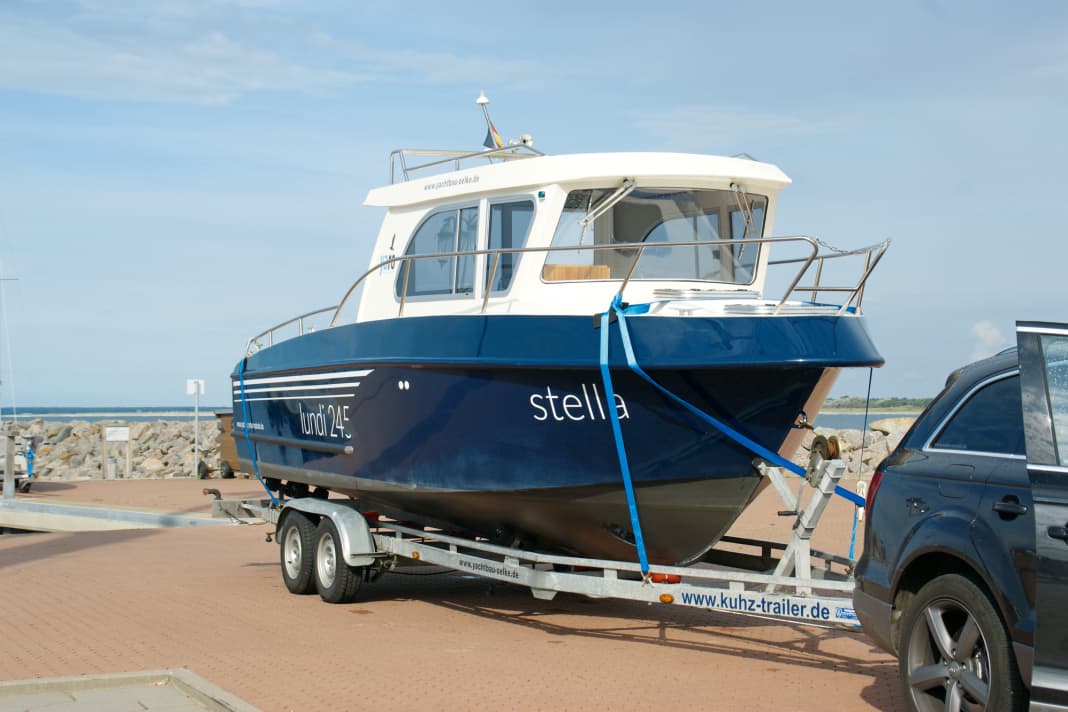





Spare wheel, spare wheel holder, side support rollers, drive-in aid, slip device, keel roller rocker, step, walkway, brake flushing kit, electric cable winch. At first glance, the list of accessories when buying a trailer seems long, very long. However, if you have to pay attention to the total weight of your trailer, you should not tick one or two boxes when selecting the extra options to be ordered and do without a little comfort. Because comfort or not - with a few exceptions, every modification to the trailer not only increases the final total on the invoice, but also the trailer's own weight.
In the popular family cruiser boat class, there is usually no way around the 3.5 t class. However, the weight specifications of the boat manufacturers are often not one hundred per cent correct. After the first trip to the scales, which hopefully takes place before the first police check, many trailer captains first have to sharpen their pencils and see where they can save weight on the boat or trailer. By customising almost every boat, it is often possible to comply with the legal weight specifications after all.
- Here go to the trailer overview
Steel or aluminium trailer?
The first kilos of material can be rationed for the trailer. Of course, the main material of the frame and the add-on parts plays a very important role in the maximum payload. You can usually choose between galvanised steel or aluminium. A rarity on the market is the stainless steel version from the Dutch company Vanclaes. Both commonly used materials have their advantages and disadvantages. While the aluminium trailer often offers a higher payload, there are also compromises to be made. Starting with the price, as aluminium is significantly more expensive as a raw material than standard steel. The aluminium version often costs almost twice as much as the steel trailer. Every kilo of additional load must therefore be purchased at a high price. The softer raw material aluminium also warps considerably more. Overloading, as well as tension and vibrations during trailering, can lead to cracks and fractures in the frame and at welded points more quickly. The life expectancy of a steel trailer is therefore usually longer than that of its aluminium competitor.
In addition, you should not drive an aluminium trailer into salt water if there is no other option. Corrosion immediately attacks every little scratch or blemish on the often powder-coated trailers and blossoms. The hot-dip galvanisation of the steel trailer is much more grateful here. Due to the noticeably more stable and stiffer material, a steel trailer often runs a little more unevenly behind the trailer than a much more torsion-resistant aluminium trailer. All add-on parts such as axles and drawbar ends are often identical for the different trailer manufacturers, as they are supplied by the same producers. Weight savings in this segment are therefore rarely possible.
Manufacturers rely on plastic add-on parts to save weight
In order to save weight, some manufacturers are already using plastic add-on parts, such as mudguards. Replacing the steel cable with a heavy-duty belt offers further savings potential. As boats that require a 3.5-tonne trailer are craned more often than they are slipped, further weight can be saved by using rollers and tilting devices that are not absolutely necessary.
However, Sigma offers an interesting alternative for those who reach the 3,500 kg limit even after all the weight savings in the equipment: depending on the towing vehicle and the associated drawbar load, the Ultralight model with its 3,650 kg total weight is another option for teasing out a few more kilos of payload.
Trailer overview
(manufacturer, type, unladen weight, payload, length, price, contact)
Aluminium trailer
- Sigma, ST 3500, 494 kg, 3006 kg, from 8,500 mm frame length, from € 13,313, www.suedwestmarine.de
- Steinbacher, MBT 3500 WA, 550 kg, 2950 kg, from 8,100 mm frame length, from € 12,540, www.steinbacher-trailer.de
- Harbeck, BT 3500 MAL, 550 kg, 2950 kg, from 8,100 mm frame length, from € 11,760, www.harbeck.de
- Wörmann, Sealiner 3500 aluminium, 582 kg, 2918 kg, from 7,990 mm frame length, from € 7,360, www.woermann.eu/de
- Temared, B35, 585 kg, 2915 kg, from 9,800 mm frame length, on request, www.temared.com/de
Stainless steel trailer
- Vanclaes, Excelleron 3500, 600 kg, 2900 kg, from 7,500 mm frame length, from € 10,223, www.vanclaes.com/de/
Steel trailer
- Bunnefeld, 3500, 600 kg, 2900 kg, up to 8,800 mm boat length, from € 4,880, www.bunnefeld-anhaengerbau.de
- Kuhz, BTK3500V, 600 kg, 2900 kg, from 8,400 mm frame length, from € 5,363, www.kuhz-trailer.de
- Vlemmix, SMT 3500, 620 kg, 2800 kg, up to 9,500 mm boat length, from € 4,980, www.vlemmix.de
- Ohlmeier, MT3500, 640 kg, 2860 kg, from 8,000 frame length, from € 7,955, www.ohlmeier-trailer.de
- Arco, 3500 TM, 650 kg, 2850 kg, from 8,500 mm frame length, from € 6,510, www.arco-trailer.de
- Marlin, BT 3500, 650 kg, 2850 kg, up to 9,000 boat length, from € 6,249, www.marlintrailer.de
- HEKU, B3500, 650 kg, 2850 kg, from 7,500 mm frame length, from € 6,075, www.heku-fahrzeugbau.de
- Wick, 35.80-18, 660 kg, 2840 kg, from 8,000 mm frame length, from € 6,880, www.wick-bootstrailer.de
- TPV, BA 3500L, 662 kg, 2838 kg, up to 8,500 mm boat length, from € 4,999, www.tpv-anhaenger.de
- Böckmann, BA 3500, 668 kg, 2832 kg, up to 8,500 mm boat length, from € 4,799, www.boeckmann.com/de
- Pongratz, PBA 3500, 699 kg, 2801 kg, from 8,300 mm frame length, from € 8,039, www.pongratztrailers.com
- Brenderup, 263500TB SRX, 700 kg, 2800 kg, up to 7,800 mm boat length, on request, www.brenderup.com
- Pega, V 3500, 750 kg, 2750 kg, from 8,500 mm frame length, from € 9,850, www.pegabv.nl/PEGAde

